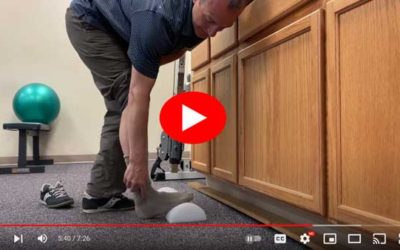Why Does my Knee Replacement Make Noise?

Introduction
Experiencing clicking, popping, or other noises in the knee joint after a knee replacement surgery can be concerning for many patients. As a licensed physical therapist, I understand that these sounds can raise questions about the success of the surgery and whether any complications have arisen. The good news is that, in most cases, these noises are a normal part of the healing process after a knee replacement. In this article, we will discuss the different types of sounds you may experience, such as knee replacement clicking and popping, and what they could mean for your recovery.
While I will provide a comprehensive overview of this topic, it is important to remember that every individual’s recovery journey is unique. If you have concerns about your knee replacement or are experiencing pain, it is always best to consult with your orthopedic surgeon or physical therapist for personalized advice and guidance.
Knee Replacement Clicking and Popping
Clicking and popping sounds after a knee replacement are fairly common and often not a cause for concern. These sounds can result from the metal and plastic components of the prosthetic knee joint interacting with each other or from the tendons and other soft tissues surrounding the joint. In most cases, the clicking and popping noises will decrease as your body continues to heal and adapt to the new joint.
Studies have shown that most patients experience some degree of clicking and popping in the months following a knee replacement. It is important to note that these sounds are usually harmless and not indicative of any issues with the knee replacement itself. In fact, many patients will report that the clicking and popping noises subside or even disappear altogether as their recovery progresses and they regain strength and function in the knee.
If you are experiencing clicking and popping sounds after your knee replacement, it can be helpful to pay attention to when these sounds occur. Are they happening during specific activities or movements? This information can be valuable for your physical therapist, as they may be able to recommend modifications to your exercises or daily activities that could help reduce the frequency of these sounds.
While clicking and popping sounds are typically harmless, it is important to monitor any changes in your knee, such as increased pain, swelling, or joint instability. If you notice any of these symptoms or have concerns about the sounds you are hearing, it is crucial to consult your orthopedic surgeon or physical therapist for a thorough evaluation and guidance on the next steps.

Knee Replacement Noise
Besides clicking and popping, you may also experience other types of noises after a knee replacement, such as grinding or creaking sounds. Like clicking and popping, these noises are usually not a cause for concern and often decrease as you continue to heal and regain strength and function in your knee.
The grinding or creaking sounds you may hear after a knee replacement can result from the new joint surfaces moving against each other. Remember, your new knee is made of metal and plastic components that may produce some noise as they interact. As your body adapts to the new joint and your muscles and tendons strengthen, these noises should become less noticeable over time.
It is important to continue with your prescribed physical therapy exercises and follow your therapist’s recommendations to maximize your recovery and minimize knee noise. Maintaining a healthy body weight, staying active, and working on muscle strength and flexibility can also help reduce these sounds in the long term.
If the noises persist or worsen, or if you experience increased pain, swelling, or joint instability along with the sounds, it is essential to consult your orthopedic surgeon or physical therapist. They can help determine whether further evaluation or intervention is needed to address any underlying issues.
Clicking After Knee Replacement
Clicking sounds after a knee replacement are a common concern for many patients. It’s important to know that some clicking is expected during the healing process, and it usually doesn’t indicate a problem with your new knee joint.
One reason for clicking after a knee replacement is the metal and plastic components of the implant coming into contact with each other during movement. This sound is typically harmless and should become less noticeable as your body adjusts to the new joint and as you continue to progress with your rehabilitation program.
Another possible cause of clicking is the movement of tendons or other soft tissues around your new knee joint. As you recover and strengthen the muscles surrounding your knee, these clicking sounds should decrease.
It’s crucial to follow your physical therapist’s guidelines for strengthening and stretching exercises, as well as any activity modifications they suggest. These measures can help reduce clicking and ensure a smooth recovery process. If clicking sounds persist or worsen, or if they are accompanied by pain, swelling, or instability, make sure to discuss your concerns with your orthopedic surgeon or physical therapist. They can help determine if there is an underlying issue that requires further investigation or intervention.

Popping in Knee After Knee Replacement
Similar to clicking, popping sounds in the knee after a knee replacement surgery can also cause concern for patients. It’s essential to understand that occasional popping sounds are not uncommon and typically do not indicate a significant issue with your new knee joint.
Popping in the knee after a knee replacement can be caused by the movement of the soft tissues around your new joint, such as tendons and ligaments. As your body heals and adapts to the new joint, and as you continue to strengthen the surrounding muscles, these popping sounds should become less frequent.
It’s also possible for scar tissue to form within the joint following surgery. This scar tissue may contribute to the popping sounds you hear as it moves within the joint. Generally, this is not a cause for concern and should improve over time.
During your recovery, it’s essential to follow the guidance of your physical therapist and orthopedic surgeon. They will provide you with exercises and activity modifications to promote healing and reduce the frequency of popping sounds. If popping in your knee persists, worsens, or is accompanied by pain, swelling, or instability, reach out to your healthcare provider to address any potential underlying issues.
Knee Clicking and Popping After Total Knee Replacement
Experiencing both clicking and popping sounds after a total knee replacement can be concerning for patients. However, it’s essential to remember that these sounds are generally a normal part of the healing process and should improve over time as your body adjusts to the new joint.
Clicking and popping sounds in the knee after a total knee replacement are often caused by the natural movement of the artificial joint components or the surrounding soft tissues, such as tendons and ligaments. As you continue to work with your physical therapist and follow their recommendations for strengthening exercises and activity modifications, these sounds should become less frequent.
It’s important to maintain open communication with your healthcare team during your recovery. If you notice any changes in the clicking and popping sounds in your knee, or if they are accompanied by pain, swelling, or instability, be sure to discuss your concerns with your orthopedic surgeon or physical therapist. They can help you determine if further evaluation or treatment is necessary.
In summary, clicking and popping sounds after a total knee replacement are generally not a cause for concern. By following the guidance of your healthcare team and participating in a tailored rehabilitation program, you can expect a successful recovery and a return to your daily activities with a well-functioning knee joint.
Grinding After Total Knee Replacement
Grinding after a total knee replacement can be concerning for patients, but it’s essential to understand that this sensation is not uncommon, especially during the early stages of recovery. Grinding can result from several factors, including the natural movement of the artificial joint components or the surrounding soft tissues.
As your body adjusts to the new joint and your muscles and ligaments heal, the grinding sensation should gradually decrease. It’s important to follow your physical therapist’s recommendations for exercises to help strengthen your muscles and increase flexibility, as these can improve the overall function of your knee joint and help reduce the sensation of grinding.
Additionally, you should maintain open communication with your healthcare team throughout the recovery process. If the grinding sensation worsens or is accompanied by pain, swelling, or instability, it’s essential to discuss your concerns with your orthopedic surgeon or physical therapist. They can help determine if further evaluation or treatment is necessary.
Grinding after a total knee replacement is generally not a cause for concern, and with proper rehabilitation and adherence to your healthcare team’s guidance, you should expect the sensation to diminish over time. For more information on total knee replacement and recovery, the American Academy of Orthopaedic Surgeons is a helpful resource to consult.
When to Seek Medical Attention after Total Knee Replacement
While clicking, popping, and grinding sensations after a total knee replacement are generally not cause for alarm, there are instances when you should reach out to your healthcare team for further evaluation. Understanding when to seek medical attention is crucial for ensuring a smooth recovery process and addressing any potential complications in a timely manner.
It’s essential to contact your orthopedic surgeon or physical therapist if you experience any of the following symptoms after your knee replacement surgery:
- Persistent or worsening pain that doesn’t improve with rest, ice, and over-the-counter pain medication
- Significant swelling or redness around the surgical site
- Signs of infection, such as fever, chills, or discharge from the incision
- Difficulty bearing weight on the affected leg or a feeling of instability in the joint
- Severe stiffness or loss of range of motion in the knee
- Clicking, popping, or grinding sensations that are accompanied by pain or worsen over time
Remember, your healthcare team is there to support you throughout your recovery process. Don’t hesitate to reach out with any concerns or questions you may have about your knee joint’s function and healing progress. For additional resources on post-operative care and recovery, the American Physical Therapy Association provides valuable information and guidance.
Conclusion
Experiencing clicking, popping, or grinding sensations after a total knee replacement can be concerning, but it’s important to remember that these sounds are often a normal part of the healing process. By staying informed about the causes and potential complications associated with these noises, you can better manage your recovery and ensure a successful outcome for your knee replacement surgery.
Always maintain open communication with your healthcare team, including your orthopedic surgeon and physical therapist, to address any concerns and receive personalized guidance throughout your rehabilitation journey. Staying committed to your physical therapy program and following your healthcare team’s recommendations can significantly improve your knee function and quality of life after surgery.
For more information on total knee replacement and recovery, consider exploring resources from reputable organizations like the American Academy of Orthopaedic Surgeons and the Arthritis Foundation. Remember, your healthcare team is your best resource for addressing any concerns or questions you may have during your recovery process. Don’t hesitate to reach out to them for support and guidance.
Knee Pain 1 Year After Knee Replacement Surgery
Nearly 20% of patients who have undergone total knee replacement are not happy with the outcome. [1] Dr. Scott Albright, MD. Dr. Albright is a non-surgical orthopedic specialist and in my opion one of the best sports medicine doctors in Middletown, Ohio. He has...
Is a recumbent bike good for knee replacement?
Riding a recumbent bike after a total knee replacement can be a great way to increase range of motion, increase cardiorespiratory fitness, and improve overall well being. In this video I explain some tips and tricks we use in the clinic to help clients maximize the benefit of riding this bike.
Calf Cramps How to STOP Calf Cramps
How to Stop Calf Cramps at Night When They are Happening One of the must frustrating times to get a calf cramp is in the middle of the night. You may be sound asleep when all of a sudden you experience this intense shooting pain which causes you to draw up in writhing...
3 TIPS to STOP Ankle Pain After Knee Replacement Surgery
Ankle pain after total knee replacement surgery is very common. Osteoarthritis of the knee causes the knee to change shape over time. The knee replacement surgery will correct any malalignment of the knee, but it causes excessive stress on the ankle and hip. In this...
Is a Manipulation Under Anesthesia MUA Painful
No, during a manipulation under anesthresia after a total knee replacement you will be placed under sedation and the procedure is painless. During the following 24 to 48-hours you may feel some increased soreness and swelling, but very few patients actually reqort...
Recovery After MUA Manipulation Under Anesthesia [VIDEO]
Video SeriesAnthony Maritato, PT has been a licensed physical therapist and private practice owner since 2006. Ohio license #PT011602. Anthony has been passionate about helping patients recover from total knee replacement surgery as well as rotator cuff repair surgery.




